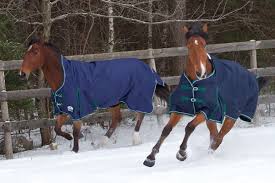Brrr. It’s cold outside! Winter is upon us. About this time of year I always start to get questions from horse owners about how best to prepare their barn and horses for the cold weather. It’s not just the temperatures though; changes in exercise routine, footing, and stabling procedures all come into play.
Far and away the majority of questions I receive from horse enthusiasts center around blanketing. I get a lot of questions about temperature cutoffs and blanket weight. I for one think that more often than not people are doing their horse a disservice when they chose to blanket. I recommend that most horses stay unblanketed almost all of the time. I think they are much better off to be allowed to naturally grow and adequate coat. Most horses regulate their body temperature in very cold and windy weather quite well. We often do them a disservice by putting a blanket on them because it compresses their fur decreasing its insulating ability and potentially causing them to sweat under the blanket. Also, I often see clients place a blanket on a horse and leave it for days or weeks. This not only creates and issue with sweating, and rubbing, but additionally no one is able to visualize the horse’s body condition on a daily basis. Additionally, blanket fit needs to be checked at least daily, preferably twice a day. I have seen more than one horse get a leg hung up in ill-fitting blankets, some of which have had disastrous outcomes.
I often hear people say “well, but it’s snowing, so he needs a blanket.” Again, horses for the most part do better if they are left on their own, even with a blanket of snow on their topline. My concern mainly is when it is rainy and very cold. This is a weather situation that can cause some individuals to have problems thermo-regulating. Horses that are shivering or exhibiting other signs of stress during cold need to be brought into a shelter, either a run in or a barn and evaluated. Attempt to dry the horse off and take his temperature. Once you have a baseline temperature, either keep in the barn blanketed or unblanketed, but continue to monitor temperature and make sure it rises to a normal level.
If the horse is used for competition or will be heavily ridden during the winter months, it may need to be clipped because it will be frequently exercising and the long hair coat will make them sweat more profusely. Additionally, debilitated horses or horses with little body mass may not be able to regulate their body temperature normally.
I also get a lot of questions related to turnout. I am a firm believer that most horses spend way too much time in the stall. Horses in general are much healthier and happier outside. They developed to constantly be walking and grazing, and keeping them standing in one place eating out of a hay net is not ideal. However, I have seen pelvic fractures, coffin bone fractures and soft tissue injuries from horses that were turned out either on icy ground or frozen ground with ruts in it. It is advisable to plan ahead and keep paddocks rotated so during the bitter months there is always a clean, safe area for turnout with good footing. Additionally, frequently pick out their feet. Ice frequently accumulates on their sole if they are wearing shoes. A good trick is to spray cooking spray or WD40 on their sole to help with the accumulation of snow. Be extra careful with horses with pour in pads or full pads as they can have limited traction. Consider adding borium during the winter months to help with traction.
I cannot stress enough the importance of keeping your horse’s activity level normal during the winter months. Often times I see horses get trained less and stalled more. This reduction in turnout and exercise can cause their GI motility to decrease, and can cause some individuals in addition to the colder temperatures, decrease their water intake, thus setting them up for an impaction. Respiratory issues can also occur. Keep a close eye on water consumption and fecal output, if any change in the daily routine changes. Blanket as little as you can for your specific horse and turnout as much as is possible and safe.
Jennifer Smallwood DVM CVA CCRP CVFT CVCH: attended the Hockaday School before receiving a BS in Animal Science from Texas A&M in 1999. In 2003 she graduated from Texas A&M University College of Veterinary Medicine and moved to Lexington, KY to complete a private practice internship which focused on equine athletes at Keeneland Race Course. It was on the racetrack that she first became interested in acupuncture as a therapeutic and diagnostic tool. She practiced in the Lexington area for ten years and over that time her practice focus shifted from traditional medicine to acupuncture. She opened her own ambulatory practice in 2008. In 2013 she moved to the Dallas area and began to grow her practice here, and started offering her services to small animals in addition to horses.


.jpg?width=90&name=email%20(1).jpg)

.jpg?width=119&name=arrow%20(6).jpg)
